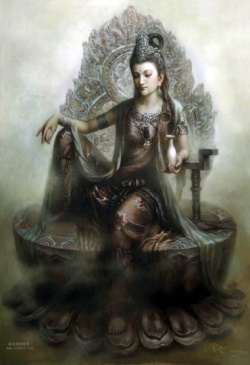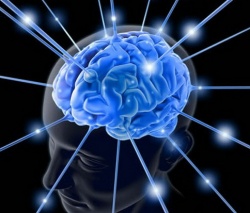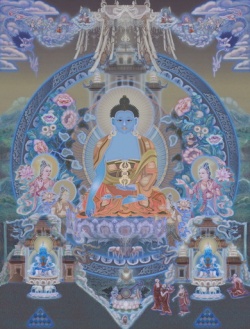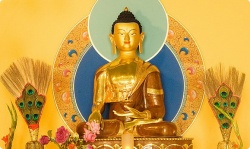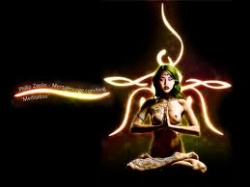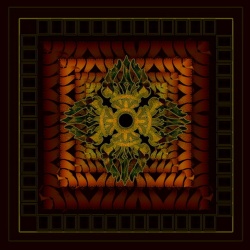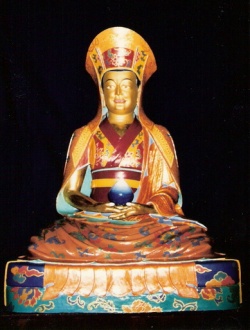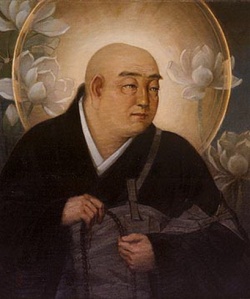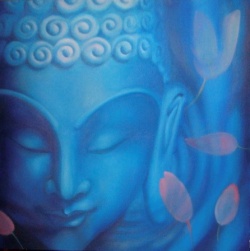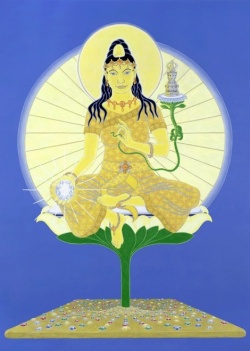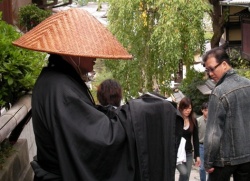Amrita: The Neuropharmacology of Nirvana by Dale Pendell
Awash in chemicals: peptides and alkaloids, hormones and enzymes, pheromones, sugars and fatty acids. Tiny neurotransmitters: nitric oxide, hydrogen sulfide, and their big buddies: phenethylamines— dopamine and epinephrine; tryptamines—serotonin and melatonin.
Feedback loops and regulators, intricate biosynthetic pathways cross linked and interwoven, like complex food-chains in a tropical forest.
Or maybe a Precambrian sea.
Which one is us? Are endorphins compassionate, adrenaline aggressive? We tend to emphasize the brain as the center of consciousness, imagine it to be a computer full of wires, but Aristotle was not incorrect when he recognized that the brain was a secretory gland.
- All in solution. Ions dissolved in synaptic fluid,
- passing through membranes—
- neurotransmitters binding to receptors,
- electronic keys probing macromolecular locks.
There are dozens of receptor types and subtypes known. Receptors occur throughout the body, not just in the brain. There are serotonin receptors on blood platelets— the immune system like a second, decentralized brain, distinguishing "self" and "other."
And the central nervous system is mirrored in the digestive tract: the "enteric" nervous system—one hundred million neurons embedded in the lining of the esophagus, stomach, and intestines, complete with neurotransmitters, synapses, and the ability to learn.
Cause or effect, hard to say: mood shifts change the chemistry, changing the chemistry alters mood.
We reflect the environment, permeable and penetrating, an analogcoded map. The protocol, deep down somewhere, perhaps wave equations, but the language is molecular: neurotransmitters are the lexicon, metabolic pathways the grammar.
Many neurotransmitters are of ancient lineage. Some of the same molecules are found in mammals and reptiles, insects and mollusks. No reason to throw out a good idea.
Some of them are also found in plants. Mostly though, like large pharmaceutical firms, plants synthesize analogs: a patented chemical that has the same functionality as its type. As plant-insect relationships are often characterized by strife as well as by love, many of these chemicals, the alkaloids especially, are poisons, usually insect poisons. They fit into the plugs and gears of some finely tuned invertebrate biosystem and monkey-wrench it.
Some plant poisons mimic neurotransmitters. And since the nervous system tends to be conservative, compared with other biological systems, these plant poisons can also mimic human neurotransmitters, or interact with human consciousness in some other way.
This is a generalization, of course. Nobody knows for sure what the plants are up to. Sometimes they spend a significant amount of their energy and resources budget on synthesizing a chemical that serves no known purpose. For the plant, anyway. For human beings, the effects of the substance can be marvelous, divine.
- Thus bhang, Cannabis sativa, is said to have sprung up where Shiva spilled a few drips of Amr̩ita, or Ambrosia, the heavenly drink of the gods. Other sacred plants, like the mushrooms, Psilocybe spp., and the peyote cactus, Lophophora, are considered deific by their peoples: the gift of God, or, indeed, the actual body of God.
Sacred plants have been our companions since the Paleolithic. In those times, the scientists and healers, the poets, and prophets, learned how to use these plants, and discovered deeper layers to the world, beyond its usual appearance. That what seems is not necessarily what is.
Possibly they discovered language. Certainly they discovered animism. They saw that the earth was alive, and that everything that happened or existed was connected to everything else. They discovered that sickness lay within, that the Self had an inner structure where dramatic scenes were enacted: theater, masks. That sometimes a person got lost while passing through this realm, so was a confused type of person, or lost something there, like a shadow, or playfully tried on one of the masks and forgot to take it off, and got stuck in it.
- Some of them saw all the way to the core: these were the Paleolithic Buddhas.
The Paleolithic plant-teaching lineage and its descendants is still alive and being practiced by many native peoples, and by a few religious sects in India and Africa. In the West, plant religions were severely persecuted, generally to extinction. A few pockets have survived, such as Amanita muscaria use by certain groups of rural Catalonians.
Buddhism, with a few possible exceptions, has mostly abandoned the use of natural substances in yogic practice, substituting instead a variety of artificial techniques.
The reasons for the rejection of psychoactive plants may well be political as much as spiritual/practical. Buddhism directly challenged the hegemony of the soma priests as spiritual and ritual authorities, and whether soma was originally the fly agaric mushroom(Amanita muscaria), as Gordon Wasson believed, Syrian rue (Peganum harmala), as David Flattery suggested, or Psilocybe cubensis, ergotized barley or rye, marijuana (Cannabis sativa), or some other plant, its consciousness-altering powers are well documented, and its use was central to the Vedic religion that formed the cultural and religious milieu from which Buddhism sprang.
It also seems likely that the rejection of psychoactive plants was a rejection of shamanism, and because many or most of the plant doctors were probably women, thus a rejection of women as spiritual teachers. It is not clear which of the two concerns was most salient.
It is clear, though, that certain classes of psychoactive plants were once much more utilized by yogic practitioners, in India and throughout the world. More, it is clear that psychoactive plants (or animals!) have been a part of, or at the very center of, religious practice in the majority prehistoric cultures, though I don't agree with those who say that psychoactive plants are the only possible origin of religion (death, to cite just one alternative, is another suitable candidate).
Traces remain, metaphors remain.
Early Buddhist psalms speak of asava, the "deadly drugs." The arhat is one who has freed himself from the four asavas: desire, speculation, ignorance, and rebirth (lust for life).
- an extract or secretion of a tree or flower;
- an outflow, flowing, or emission;
- attention or desire, the soul,
- directed outwards toward an object—
- thus, infirmity, a drug, or poison.
Images remain: Amitabha is called amritaraja, the Nectar-King.
- Amrita. Ambrosia.
- The divine nectar. The Drink of Immortality.
Amrita is closely connected to soma. The Tibetan translation for amr̩ta is dutsi. In the Buddhist version of the myth about churning the ocean to obtain ambrosia, Vajrapani turns black after drinking Rahu's dutsi - laden urine, as Shiva turns blue in the Hindu version.
In the dharani for feeding the hungry ghosts, we chant
- Adoration to Kanroo the Tathagata.
Kanroo: ambrosia. Kan plus Lou, bliss-bestowing nectar. Buddha is the poison for poison. The Buddha-dharma is the Ambrosial Drum.
Nirvana is the Nectar City, the entrance is the Ambrosial Gate.
Amr̩ta:
But Buddhist yoga has not entirely abandoned chemical aids in the quest for Realization. William McNiell, in The Rise of the West, states that Indian religiosity, and thence that of Christianity, Islam, and Chinese Buddhism, is founded and sustained by insights triggered by oxygen starvation.
A facile reduction, but perhaps with a pointer: shallow breathing, sometimes extremely shallow breathing, is indeed a salient feature of deep meditation. (Though it seems more likely that the carbon dioxide level, more than that of the dissolved oxygen, would have the profounder pharmacological activity. Two of the therapeutic indications for carbon dioxide are "negativism" and "melancholia.")
Still, as Zen students know, the best technique is no guarantor of insight. You can enter a high, altered state of consciousness and go right on sleeping. Maybe the point is not to get high, but to come down.
- But isn't that a high?
Still, it is the sesshin, the intense yogic training period, that is the context for most of our stories of kensho, Realization.
An altered state of consciousness.
Days of sitting. Pain in the legs. Not quite "sensory deprivation," but sustained, practiced focus and stillness. Bound to change one's neurochemistry: endorphins at least, and probably a lot more. And the change is often most apparent after leaving sesshin, re-entering the world and encountering familiar settings.
- The "post-sesshin high."
We can characterize it phenomenologically, as we can other drugs.
Effects: mental clarity; heightened empathetic assessment of other people; strengthening of intuitive powers; possible diminishment of certain analytical syllogistic skills. High pain threshold.
Or, some parts like a mild opium high, perhaps combined with the alertness of cocaine (again, small dose); or like half a tab of MDMA without the jaw clenching. Or like a full tab of MDMA without the jaw clenching. And some playfulness, like, well,
- A spring morning. Saturday morning.
- The birds! So many birds
- singing.
Duration: Lasts for 12 to 48 hours after leaving sesshin. Gradual tapering of effects. Mild crash, completely mitigated by sleep and more meditation.
But as will any high, you have to come down. Aitken Roshi often makes this point during his post-sesshin cautions.
The students are warned that they are in a highly sensitized and energized state. They are warned about getting involved in philosophical and intellectual discussions, about driving (timing is often altered), that, though the mind is awake and alert, the body is nonetheless tired, perhaps exhausted, and will need rest. And, of course, to avoid dissipating the experience by talking about it too much.
It's not uncommon for sangha members who did not participate in the sesshin to show up for the closing ceremony and the informal meal, visiting, and cleanup that follows, just to feel the "energy" ("contact high," we used to call that).
- "You have to come down."
An altered state of consciousness acutely suited to one task, not necessarily optimal or even appropriate to others.
Are we agreed here? Are we all agreed on this point?
Altered state/nothing special.
Altered from what?
Altered implies a norm, an unaltered state of consciousness.
The matter of sobriety.
- Hard to see, though, how an altered state of consciousness is necessary to perceive the truth of suffering.
The term "drugs" won't do: which drugs? Neither will "sobriety." Sobriety from what? Alcohol sober, but high on cannabis? Or cannabis, alcohol, and caffeine sober but under the influence of cocaine?
Or maybe nicotine sober, valium sober, and television sober, yet totally mad with love and jealousy.
Or drunk with rationality. Sober with attachment.
"Drugs," as a general term, is an obfuscation of the War on Drugs. We hear the phrase "alcohol and drugs," as if alcohol were not a drug, and as if by drugs we all know what is being talked about. Addiction is an issue with tobacco, alcohol, and the opiates, but is not at all a property of the entheogens. Addiction to alcohol, a cellular poison, is characterized by physical and mental deterioration that is virtually absent in opiate addiction. Tobacco kills nearly half a million Americans each year, but there are no recorded deaths from marijuana. Each of these plants and substances has distinct properties, promises, and dangers. All that is served by lumping a group of them together is a government program of spiritual and political oppression aimed at cutting off all dialogue.
The War on Drugs is in essence a religious war. That is why drug offenders frequently get longer prison sentences than violent criminals. A drug user is worse than a criminal—no punishment is too severe, because drug users are heretics.
Our interest here is in a special class of psychoactive plants and drugs that have acquired spiritual reputations: Psilocybe mushrooms, peyote, ayahuasca, and LSD. They are even called entheogens, "manifestinggod- within," akin to the enthusiasm of the Greek desert fathers. Ecstasy.
Meditation as a standard, a calibrating, measuring device. Meditation and koan practice as a control to assess different classes of psychotropic plants and substances.
Tea, Bodhidharma's gift, the old Barbarian's own poison, his very eyelids given for the benefit of sentient beings in their quest for realization. Some argue that that while tea is beneficial, coffee is disruptive. Some find that even tea is disturbing, strengthening the monkey more than the watcher.
Some say that MDMA is an excellent catalyst for the first day of sesshin.
- Ahhh, what about guyusa leaves,
- so low in tannins, for a pre-dawn tea?
- What about a good chew of khat,
- to subdue the drowsiness
- of a hot afternoon?
The Hevajra Tantra mentions camphor as being drunk in certain rituals to gain siddhi. In small doses, camphor is a stimulant. But in large doses, administered intravenously, camphor was used to induce convulsions in mental patients, before it was replaced with electricity. Camphor is an isomer of thujone, the active oil in wormwood, Artemisia absinthium.
Trungpa singled out marijuana as being detrimental to meditation: saying that it mimicked meditation—and forbade its use and presence. Almost everyone finds LSD much too powerful and overwhelming to be useful in practice.
Field Report, a poet and Rinzai practitioner:
- I took some LSD during a sesshin while I was in Japan. It was too much, too exaggerated. Everything was too perfect and meaningful. The timing and sound of the bells had cosmic significance. The monks were so beautiful that I wanted to cry.
- Everything was so numinous.
- [Did you get a koan answer?]
- Oh yes. I found a great, perfect answer.
- [Did you go to dokusan?]
- Yes.
- [And . . .?]
- Oh, it was wrong, of course. I mean I had a great, perfect answer, but it wasn't the point of the koan at all.
The salient feature of entheogens in American Buddhism at present is memorial: that many Americans not born to Buddhism were attracted to it in the first place because of psychedelic revelations. If, as some pedants claim, such experiences are not "genuine," their persistence is remarkable indeed.
Very few dedicated students seem interested in using psychedelics WITHIN the context of the Buddha-way, but even fewer recant the importance or significance of their previous experiences. Most of them claim that the Buddha-way is a natural extension or progression of their psychedelic experiences. Many leave open the possibility of renewing their acquaintance with entheogenic plants or substances in the future.
- Maybe it’s not that visionary plants and drugs are useful for Zen training, but that Zen training is excellent preparation for using psychedelic drugs.
No amount of meditation is going to give you an LSD experience.
Is there something MISSING, a barren area in Buddhism, that these sacred plants and medicines address?
- We had all walked down to the beach. It seemed like everyone was talking at once. Tim was crying and laughing at the same time, came over and started hugging me.
- "All this time, my whole life, I've been embarrassed about my teeth—that's all it was—so I wouldn't smile—just because of my teeth I've been stopping myself from smiling."
This promise, this chance, that through insight, revelation, through discovered/recovered facility, that obstacles be dissolved and the ego be strengthened and healed.
- Crying and laughing, hugging.
At any point on this continuum, the matter of the fifth precept may be addressed.
- Surāmeraya-majjappa-mādahānā
- veramanī-s̩ikkhāpadam̩-samādiyāmi
"I undertake the training rule to abstain from fermented and distilled intoxicants which are the basis for heedlessness."
Surā refers to spiritous, flavored liquors, though it is not clear that this has always specifically meant distilled alcoholic beverages, as five kinds of surā are mentioned in the Veda.Meraya refers to any sort of fermented beverage; Rhys-David says that there were five kinds. Majja is an intoxicant, from a very ancient Indo-European root with cognates that include words for mead, madness, passion, and rejoicing. Rhys- David suggests "indolence" for pamada instead of "heedlessness."
The most literal interpretation of the precept is clearly directed against alcohol, and, more specifically, against its deleterious effects on mindfulness and morality. Opium, at the time of the Vinaya was almost certainly viewed purely as a medicine and not as an intoxicant. The absence of bhang from the precept, however, may be significant, because hemp was indeed used in some yogic practices, and has left traces in both Hindu and Buddhist tantra.
Bhikkhu Bodhi stresses the heedlessness that arises from intoxication as the point of the precept.
- Under the influence of intoxicants a man who might otherwise be restrained can lose self-control, become heedless, and engage in killing, stealing, adultery, and lying. Abstinence from intoxicants is prescribed on the grounds that it is essential to the selfprotection of the individual and for the well-being of family and society. The precept thus prevents the misfortunes that result from the use of intoxicants: loss of wealth, quarrels and crimes, bodily disease, loss of reputation, shameless conduct, negligence, and madness.
But we have to go further. We will not dally in the literal. The precept is about delusions.
- But sobriety also deludes.
- If sobriety did not delude,
- there would be no Buddhists,
- no one lighting incense and chanting Kanzeon.
The precept is about not muddying the waters.
But there is something muddy about many commentaries on the fifth precept, when "intoxicants" are glossed in a lump to "drugs". Characterizations such as "semi-conscious euphoria," or "heedless loss of self-control", or "haze that clouds the mind" bear little affinity with the ecstatic epiphanies and insights of the psychedelic experience. Still. Such ignorance should not limit our own investigations. We know something about delusion, and something about the seductive powers of Mara's beautiful daughters.
- Self-nature is subtle and mysterious. In the realm of the intrinsically pure Dharma, not giving rise to delusion is called the Precept of Not Giving or Taking Drugs. ::—Bodhidharma
Drugs have not been brought into it. Don't bring them in.
Which drugs? Bodhidharma's eyelids? Carbon dioxide volume?
In another sense the poisons were there from the beginning. Maybe they are the beginning: a grand hallucination of seeming. Of eyes, taste, touch, thought, and object of thought.
- Birth, death, and dreaming:
- beta-carbolines shielding tryptamines,
- carbohydrates in a controlled burn.
- Rice as a powerful hallucinogen.
Medicinal use of drugs is excepted from the precept.
We bless the rice and vegetables we eat at sesshin as "this good medicine." And supper is considered "medicine," not a meal at all— therefore not transgressing the rule that monks eat only twice a day.
- Yun Men, teaching his community, said, “Medicine and disease subdue each other: the whole earth is medicine. What is your self?
- -Blue Cliff Record case 87
The earth comes forth to confirm the self: tonight's cold wind; a warm cup of soup.
Different diseases require different medicines.
- But are we not ill? Dukkha?
- Are we not, like all conditioned and composite dharmas, ill?
- And is not one of the greatest illnesses the frozen, reified belief in
- the ultimate nature of external objects?
- Or its converse?
The question of entheogenic drugs more generally is the question of ecstatic visions. Divine madness. Makyō
Makyō: the Path of Illusions; Path of Dreams. A feeling of great numinosity.

Ma, hemp-spirit, Mara, the devil in the phenomenal world. Makyō are visions that appear at certain stages of the meditation path.
- A deep dream of participation in the Buddha Dharma. ::—Robert Aitken
The Surangama Sutra lists fifty types of makyō, ten for each of the five aggregates of form, receptiveness, conception, discrimination, and consciousness. The Buddha states that these visions are harmless, even excellent progressive stages, unless the practitioner believes that they signify complete attainment.
- In this clear and penetrating state of your mind when it looks within, its light appears in all its purity and at midnight you will suddenly see in your dark room all sorts of apparitions as clearly as in broad daylight, with all the other objects usually there. This is the mind, in its subtlety, refining its clear perceptions which enables you to see distinctly in the dark. This temporary achievement does not mean you are a saint. If you do not regard it as such, it is an excellent progressive stage, but if you do you will give way to demons.
To poison poison, the Peacock Path. The way of transmutation.
The blue color of the peacock is the blue of Shiva, the blackness of Vajrapani: the color of the poison-drinker.
- In jungles of poisonous plants strut the peacocks . . .
- — Dharmaraksita: Wheel of Sharp Weapons: A Mahayana Training of the Mind
The Boddhisattva of Makyō, the Poison Buddha, The Bodhisattva of Illusions: the buddha with 108,000 names who teaches and saves with illusion. Whose very name poisons preconceptions, who leaves us in a soup of dreams.
We know this path in our imaginations, or is it our memories? A path that includes ecstasy and ecstatic visions, the God of Ecstasy, Shiva, or maybe Dionysus: the Bodhisattva who gave us his very blood as a medicine for crippling inhibitions, that the true soul emerge.
Dionysus, by nature unrecognized, but surely present in the pantheon: a young god with the rank of bodhisattva.
Iconography: sometimes rides a panther, sometimes an ass. Androgynous. Usually with long hair. associated with the thyrsus and tambourine, wears a garland of ivy leaves (a cure for drunkenness). God of music, poetry, song, and the theater. Dharani may include eating wild mushrooms, and raw flesh (emblamatic of the food web and interdependence).
Associated with springtime, and an ecstatic state of consciousness often mistaken for madness, but more appropriately named Great Joy. Enthusiastic exuberance.
Wrathful aspect: hawk eating a ground squirrel; cat playing with a mouse, waiting, letting it revive and run in order to catch it again. Two schoolgirls catching fireflies, pulling the abdomens off and sticking them onto their arms and the backs of their hands, dancing and laughing, their jewelry aglow with green light.
Let a thousand schools flourish, the way of Buddhism is assimilation, not rejection. The Divine Madness school of Buddhism, watched over by the Bodhisattva Dionysus, who uses enthusiasm and ecstatic visions as devices . . .
- And thus Bodhisattvas are likened to peacocks:
- They live on delusions - those poisonous plants.
- Transforming them into the essence of Practice,
- They thrive in the jungle of everyday life.
- Whatever is presented they always accept,
- While destroying the poison of clinging desire.
